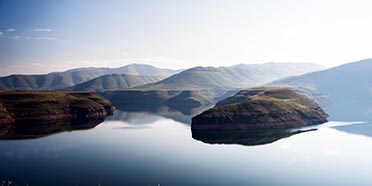
Ariadne is a renowned African wildlife photographer whose work is featured in many well-known guidebooks and magazines.
2 people found this review helpful.
Kingdom in the sky
The Kingdom of Lesotho is surrounded entirely by South Africa. It is nothing like its more industrialized neighbor though. When you cross the border, you feel like you go back in time. The small country is refreshingly undeveloped, and most people still live a very traditional lifestyle. What’s most striking about Lesotho is how mountainous it is. In fact, it is the only country in the world to be entirely above 1000m, hence its nickname ‘Kingdom in the sky’. Lesotho’s extreme topography makes it an ideal playground for 4x4-enthusiasts and adventure seekers. Activities include pony trekking, mountain biking, skiing (in winter), paragliding and fly-fishing. And then there is the world’s longest abseil; a thrilling 204m descent next to the spectacular Maletsunyane Falls.
There are very few roads in Lesotho and the only two national parks are best explored on foot or on horseback. This isn’t a safari destination; the main attraction is the spectacular mountain scenery. However, seeing animals on foot is always unexpected and special. I was lucky to see several herds of eland (Africa’s largest antelope), grey rhebok, jackals, Chacma baboons and lots of rock hyrax. Most endearing is the ice rat, a Lesotho near-endemic only found at high altitude.

Philip is an acclaimed travel writer and author of many guidebooks, including the Bradt guides to Uganda, Tanzania, Kenya and South Africa.
Magical mountain kingdom
Lesotho is like no other African country. Enclosed by South Africa, this small mountainous kingdom lies entirely above 1,388m (the highest national low point in the world), while 3,482m Thabana Ntlenyana, on the eastern escarpment, is Africa’s loftiest peak south of Kilimanjaro.
Few people visit Lesotho to see large wildlife. Indeed, while a network of parks and reserves supports the likes of eland, grey rhebok, baboon, rock hyrax and various small carnivores, none of the Big Five is present anywhere in Lesotho. By contrast, it is a wonderful botanical destination. Together with South Africa’s neighbouring uKhahlamba-Drakensberg Park, Lesotho forms part of a hub of ancient floral biodiversity known as the Drakensberg Alpine Centre. You’ll see a profusion of wildflowers during the rainy summer months of November to April, while autumn and winter are when the stunning red-hot pokers and aloes come into bloom.
A highlight of my visit to Lesotho was the spectacular montane scenery of golden sandstone cliffs, towering basaltic peaks and plunging waterfalls, best seen at the likes of Sehlabathebe National Park, Sani Top and Semonkong. We often drove or hiked past traditional stone-and-thatch villages, or blanketed shepherds roaming the countryside on horseback, emphasising the deep traditions that still inform Sotho society today. Other highlights include the magnificent prehistoric rock art that adorns the remote Tsatsane and Sebapala valleys, and the fortress-like sandstone plateau of Thaba Bosiu, which was the military stronghold of King Moshoeshoe I – founder of the Sotho nation – from 1824 until his death in 1870.
I was very impressed by Lesotho’s birdlife. The checklist of 350 bird species includes roughly half those whose natural range is restricted to South Africa, Lesotho and/or Swaziland (recently renamed Eswatini). We had excellent views of several of these localised specials, notably southern bald ibis, ground woodpecker, Drakensberg rockjumper, Drakensberg siskin and bush blackcap. Lesotho is the focal point for southern Africa’s last viable breeding population of the magnificent bearded vulture, and while we never saw this, we did enjoy views of several other notable birds including jackal buzzard, Cape vulture, blue crane and malachite sunbird.

Lizzie is a reputed guidebook writer and author of the Footprint guides to South Africa, Namibia, Kenya, Tanzania, Uganda and Zimbabwe.
Lesotho, the ‘Kingdom in the Sky’, a proudly independent country surrounded by South Africa
Dominated by the Maloti Mountains and a dramatic escarpment with the Drakensberg in South Africa, Lesotho’s nickname is apt – not one of its 30,355-sq-km lies below 1000-metres and many of its beautiful peaks reach above 3000-metres. In the west, a small strip of land flattens out into the Lowlands, where most of the towns are (and the majority of the population lives), including the small (and miss-able) capital of Maseru. Instead head into the highlands where mountains are spiked with stark rock, sweeping plateaus are peppered with thatched villages, herder boys and farmers on horseback roam the grassy pastures, and frothy rivers are tamed by massive dams. It’s not the easiest place to navigate, and while I’ve found driving tricky (steep passes and potholes); the rewards have been magnificent views and off-the-beaten-track adventures. Many visitors hire cars in South Africa, but tour companies from Durban or Johannesburg include Lesotho in their itineraries too.
The top things to do are hiking and trekking with sure-footed mountain Basotho ponies, both of which open up even the most remote areas that are inaccessible by vehicle. My favourite place is Malealea – a Basotho village that has a former trading-post lodge with a variety of accommodation, and a community-based tourism initiative that offers activities from pony-trekking and mountain-biking to hikes to see San rock art and traditional village visits. A similar option is Semonkong Lodge that arranges things to do including pony-trekking, hiking, abseiling, trout-fishing and rock climbing. There are also national parks and nature reserves, such as Ts’ehlanyane, Sehlabathebe and Bokong, but with altitudes of above 2000–3000-metres don’t expect to see wildlife except maybe hardy antelope like eland, mountain reedbuck and rhebok. But they are ideal for challenging hiking and you may spot birds of prey such as rock kestrels and bearded vultures.
Lesotho is a vastly underrated travel destination and the contrast with South Africa could not be more striking. It will appeal to those wanting raw adventure and natural beauty and even just a few days in its mountain lodges and trading posts will give you a fresh perspective on Southern Africa.



